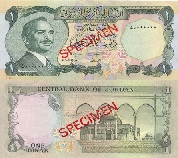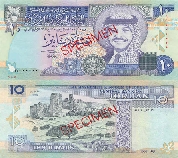| دينار أردني (Arabic) | |
|---|---|
 Fifth edition Jordanian bank notes and coins | |
| ISO 4217 | |
| Code | JOD (numeric: 400) |
| Subunit | 0.001 |
| Unit | |
| Symbol | د.أ |
| Denominations | |
| Subunit | |
| 1⁄10 | dirham |
| 1⁄100 | qirsh or piastre |
| 1⁄1000 | fils |
| Banknotes | 1, 5, 10, 20, 50 dinars |
| Coins | 1, 5, 10 piastres/qirsh, 1⁄4, 1⁄2 dinar |
| Demographics | |
| Date of introduction | 1949 |
| Replaced | Palestine pound |
| Official user(s) | |
| Unofficial user(s) | |
| Issuance | |
| Central bank | Central Bank of Jordan |
| Website | www |
| Valuation | |
| Inflation | 1.35% |
| Source | The World Factbook, 2021 est. |
| Pegged with | US dollar[1] US$ = JOD 0.708 (buy) US$ = JOD 0.71 (sell) |
The Jordanian dinar (Arabic: دينار أردني; code: JOD; unofficially abbreviated as JD) has been the currency of Jordan since 1950. The dinar is divided into 100 qirsh (also called piastres) or 1000 fulus. Fils are effectively obsolete; however, monetary amounts are still written to three decimal places representing fils. It is pegged to the US dollar.
The Central Bank of Jordan commenced operations in 1964 and became the sole issuer of Jordanian currency, in place of the Jordan Currency Board.
The Jordanian dinar is also widely used in the West Bank alongside the Israeli shekel.[2][3]
In 1927, the British administration of the Palestinian Mandate established the Palestine Currency Board which issued the Palestine pound which was the official currency in both Mandatory Palestine and the Emirate of Transjordan. Though Jordan became an independent kingdom on 25 May 1946, it continued to use the Palestinian pound for a while. In 1949, it passed the Provisional Act No. 35 of 1949, which established the Jordan Currency Board as the sole authority in the kingdom entitled to issue Jordanian currency, called the Jordanian dinar. The Board was based in London and consisted of a president and four members, and began issuing Jordanian dinars in 1949 and was exchangeable for Palestinian pounds at parity.
After Jordanian occupation of the West Bank in April 1950, the dinar replaced the Palestinian pound. On 1 July 1950, the Jordanian dinar became the kingdom's official currency and legal tender. The use of the Palestine pound ceased in the country on 30 September 1950. The Central Bank of Jordan was established in 1959 and took over note production in 1964. In 1967, Jordan lost control of the West Bank, but the Jordanian dinar continued to be used there. It continues to be widely used in the West Bank alongside the Israeli shekel.[2]
Coins were introduced in 1949 in denominations of 1, 5, 10, 20, 50 and 100 fils. The first issue of 1 fils were mistakenly minted with the denomination given as "1 fil". 20 fils coins were minted until 1965, with 25 fils introduced in 1968 and 1⁄4 dinar coins in 1970. The 1 fils coin was last minted in 1985. In 1996, smaller 1⁄4 dinar coins were introduced alongside 1⁄2 and 1 dinar coins.
Until 1992, coins were denominated in Arabic using fils, qirsh, dirham and dinar but in English only in fils and dinar. Since 1992, the fils and dirham are no longer used in the Arabic and the English denominations are given in dinar and either qirsh or piastres.
| Value | Diameter | Weight | Composition | Edge | Obverse | Reverse | First Minted Year | Common Reference |
|---|---|---|---|---|---|---|---|---|
| 1 qirsh | 25 mm | 5.5 g | Copper-plated steel | Plain |  |
 |
2000 | |
| 5 piastres (qirsh) | 26 mm | 5 g | Nickel-plated steel | Milled |  |
 |
2000 | 50 fils 'Shilin' |
| 10 piastres (qirsh) | 28 mm | 8 g |  |
 |
100 fils, 'Bareezah' | |||
| 1⁄4 dinar | 26.5 mm Heptagonal |
7.4 g | Brass | Plain |  |
 |
2004 | Rub'a1, 25 piastres, 250 fils |
| 1⁄2 dinar | 29 mm Heptagonal |
9.6 g | Ring: Aluminium bronze Center: Cupronickel |
Plain |  |
 |
2000 | Nusf2, 50 piastres, 500 fils |
The Central Bank of Jordan is the sole authority to issue Jordanian banknotes since its establishment in 1964. It released into circulation its first series of Jordanian notes on August 4, 1965. From 1949 to 1965, currency issue was entrusted in the Jordan Currency Board. Before 1949, the Palestinian pound was used.[4]
In 1949, banknotes were issued by the Jordan Currency Board in denominations of 1⁄2, 1, 5, 10 and 50 dinars. They bore the country's official name, "The Hashemite Kingdom of the Jordan".[5] 20 dinar notes were introduced in 1977. The 50 dinar note was redesigned and the 1⁄2 dinar notes were replaced by coins in 1999.
| Obverse | Reverse | Value | Dimensions | Primary Color | Obverse | Reverse | Printed Date |
|---|---|---|---|---|---|---|---|
 |
 |
500 fils | 128 x 76 mm[7] | Dark Purple | Wadi Al Arab Irrigation Project[7] | View of shepherd with his flock[7] | 1949 (Gregorian)
1368 (Hijri) |
 |
 |
1 dinar | 160 x 86 mm[8] | Green | The late His Majesty King Abdullah | Oval Plaza - Jerash[8] | |
 |
 |
5 dinar | 169 x 88 mm[9] | Red | View of Al-Khazneh[9] | ||
 |
 |
10 dinar | 185 x 97 mm[10] | Blue | |||
 |
 |
50 dinar | 190 x 100 mm[11] | Brown | View from Aqaba[11] |
| Obverse | Reverse | Value | Dimensions | Primary Color | Obverse | Reverse | Printed Date |
|---|---|---|---|---|---|---|---|
 |
 |
500 fils | 128 x 76 mm[13] | Dark Purple | Wadi Al Arab Irrigation Project[13] | View of shepherd with his flock[13] | 1952 (Gregorian)
1371 (Hijri) |
 |
 |
1 Dinar | 160 x 86 mm[14] | Green | His Majesty the late King Hussein bin Talal | Oval Plaza - Jerash[14] | |
 |
 |
5 Dinar | 169 x 88 mm[15] | Red | View of Al-Khazneh | ||
 |
 |
10 Dinar | 185 x 97 mm[16] | Blue |
| Obverse | Reverse | Value | Dimensions | Primary Color | Obverse | Reverse | Issue Date |
|---|---|---|---|---|---|---|---|
 |
 |
1⁄2 dinar | 140 x 70 mm[18] | Dark Orange | His Majesty the late King Hussein bin Talal | Oval Forum - Jerash[18] | August 4,
1965[18] |
 |
 |
1 dinar | 150 x 75 mm[18] | Green | Dome of the Rock[18] | August 4, 1965[18] | |
 |
 |
5 dinar | 164 x 82 mm[19] | Red | View of Al-Khazneh[19] | August 4, 1965[19] | |
 |
 |
10 dinar | 175 x 88 mm[20] | Blue | Al-Maghtas[20] | August 4, 1965[20] |
| Obverse/Reverse | Value | Dimensions | Primary Color | Obverse | Reverse | Issue Date |
|---|---|---|---|---|---|---|
 |
1⁄2 dinar | 136 × 67.5 mm[22] | Brown | His Majesty the late King Hussein bin Talal | Oval Forum - Jerash[22] | November 16, 1975[22] |
 |
1 dinar | 144 × 71.5 mm[23] | Green | Dome of the Rock[23] | November 16, 1975[23] | |
 |
5 dinar | 152 × 76 mm[24] | Red | View of Petra[24] | November 16, 1975[24] | |
 |
10 dinar | 160 × 80 mm[25] | Dark Purple | The Cultural Palace at Al-Hussein Youth Sports City Roman Amphitheater (Amman)[25]
Three Roman columns in Jerash |
November 16, 1975[25] | |
  |
20 dinar | 168 × 84 mm | Olive Green/Blue[26] | View of the Al-Hussein Thermal Power Station in Zarqa
Olive grove[27] |
June 3, 1978 (Olive Green)[4]
August 25, 1990 (Blue)[26] |
| Obverse/Reverse | Value | Dimensions | Primary Color | Obverse | Reverse | Issue Date |
|---|---|---|---|---|---|---|
 |
1⁄2 dinar | 131 × 62 mm[29] | Brown | Hussein bin Talal | Qusayr 'Amra[29] | August 1, 1992[29][30] |
 |
1 dinar | 137 × 66 mm[30] | Green | The Cardo in Jerash[30] | ||
 |
5 dinar | 143 × 70 mm[31] | Red | Al-Khazneh[31] | October 1, 1992[31][32] | |
 |
10 dinar | 149 × 74 mm[32] | Blue | Ajloun Castle[32] | ||
 |
20 dinar | 155 × 78 mm[33] | Olive green and gray | Dome of the Rock[33] | August 1, 1992[33] |
| Obverse | Reverse | Value | Dimensions | Main Color | Obverse | Reverse | Printed Date | Issued Date | Watermark |
|---|---|---|---|---|---|---|---|---|---|
 |
 |
1 dinar | 133 × 74 mm[34] | Green |
|
|
2002 Hijri 1423 |
March 30, 2003[34] | Sharif Hussein bin Ali |
 |
 |
5 dinars | 137 × 74 mm[35] | Brick orange |
|
|
December 22, 2002[35][36] | Abdullah I bin al-Hussein | |
 |
 |
10 dinars | 141 × 74 mm[36] | Blue |
|
Talal bin Abdullah | |||
 |
 |
20 dinars | 145 × 74 mm[37] | Brown and Olive Green | February 2, 2003[37][38] | Hussein bin Talal | |||
 |
50 dinars | 149 × 74 mm[38] | Brown and Purple |
|
Abdullah II bin al-Hussein |
| Obverse | Reverse | Value | Dimensions | Main Color | Obverse | Reverse | Printed Date | Issued Date | Watermark |
|---|---|---|---|---|---|---|---|---|---|

|

|
1 dinar | 133 × 74 mm[4] | Green |
|
|
2022 Hijri 1443 |
26 December 2022 | Sharif Hussein bin Ali |

|

|
5 dinars | 137 × 74 mm | Orange | Treasury, Petra | 16 August 2023 | Abdullah I bin al-Hussein | ||

|

|
10 dinars | 141 × 74 mm | Blue | Roman Theater in Amman | 26 July 2023 | Talal bin Abdullah | ||

|

|
20 dinars | 145 × 74 mm | Cyan | Wadi Mujib | 21 March 2023 | Hussein bin Talal | ||

|

|
50 dinars | 149 × 74 mm | Purple | Wadi Rum | 5 February 2023 | Abdullah bin al-Hussein II |
Since October 23, 1995, the dinar has officially been pegged to the IMF's special drawing rights (SDRs), while in practice it was fixed at 1 U.S. dollar = 0.709 dinar most of the time, which is approximately 1 dinar = 1.41044 dollars.[40][41] The Central Bank buys U.S. dollars at 0.708 dinar per dollar, and sells U.S. dollars at 0.710 dinar per dollar.[42]
| Current JOD exchange rates | |
|---|---|
| From Google Finance: | AUD CAD CHF CNY EUR GBP HKD JPY USD ILS EUR JPY |
| From Yahoo! Finance: | AUD CAD CHF CNY EUR GBP HKD JPY USD ILS EUR JPY |
| From XE.com: | AUD CAD CHF CNY EUR GBP HKD JPY USD ILS EUR JPY |
| From OANDA: | AUD CAD CHF CNY EUR GBP HKD JPY USD ILS EUR JPY |
A sample exchange rate of Jordanian dinars to US dollars:
| Year | US Dollar = |
|---|---|
| 1980 | 0.29 dinar |
| 1985 | 0.39 dinar |
| 1990 | 0.66 dinar |
| 1995 | 0.70 dinar |
| 2020 | 0.71 dinar |
((cite web)): Missing or empty |title= (help)
Currencies named dinar or similar | |
|---|---|
| Circulating |
|
| Defunct | |
| As subunit |
|
| See also |
|
Currencies of Asia | |
|---|---|
| Central | |
| East | |
| North | |
| South | |
| Southeast | |
| West |
|